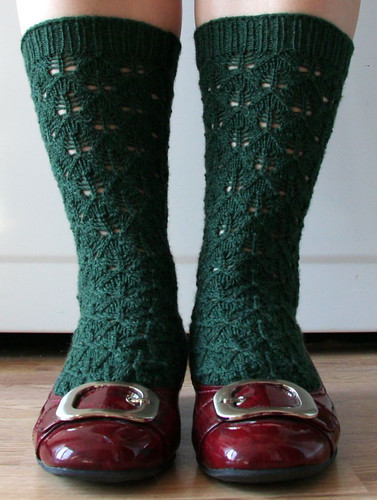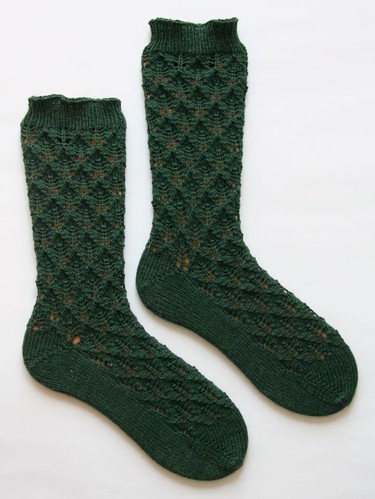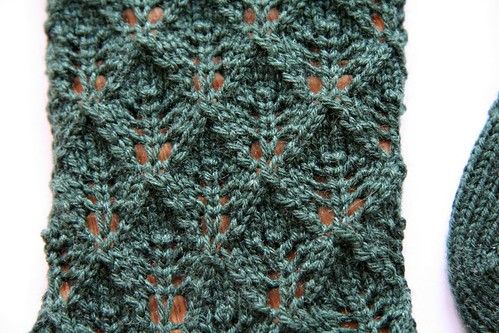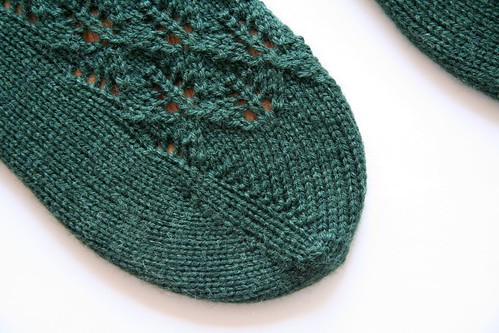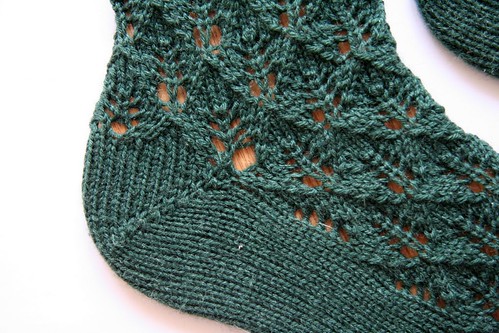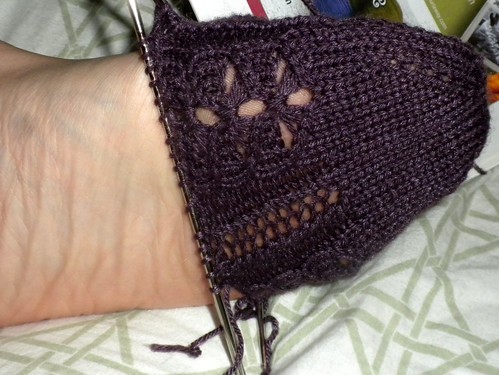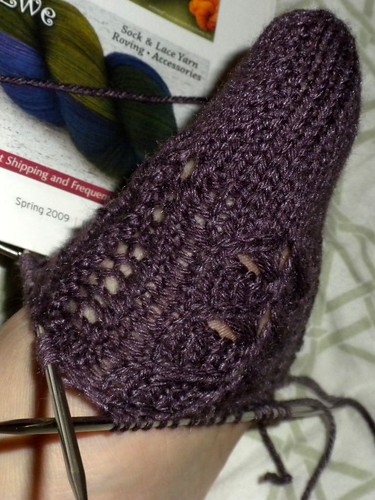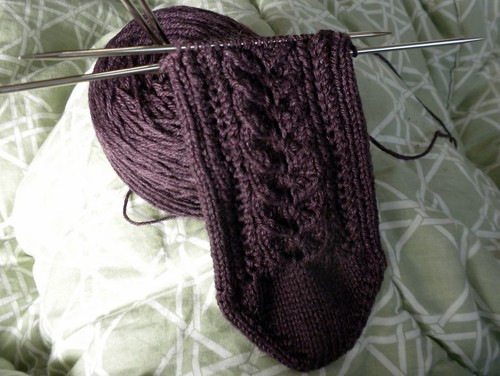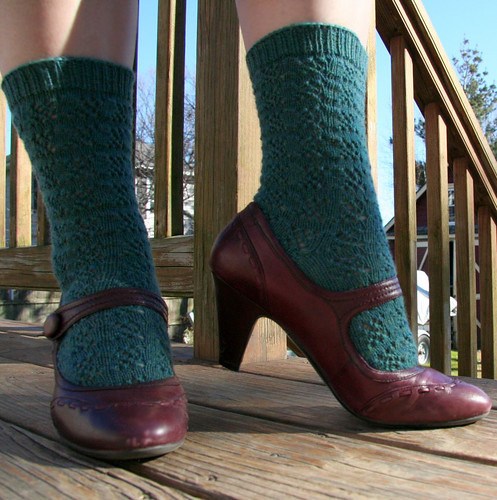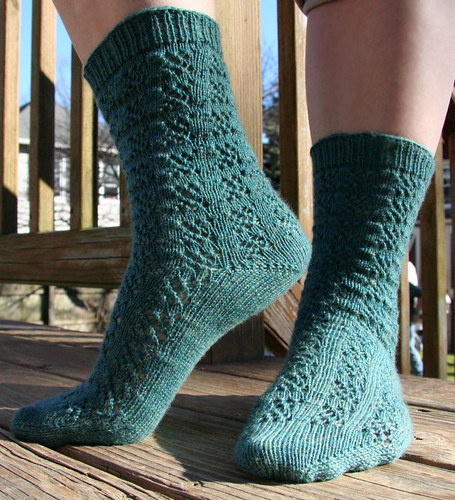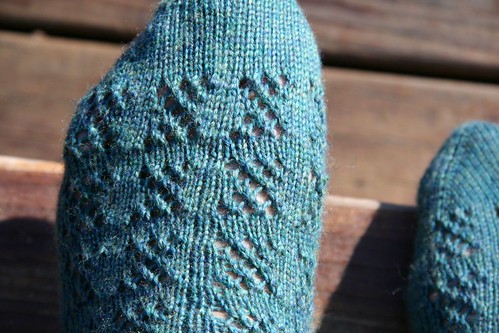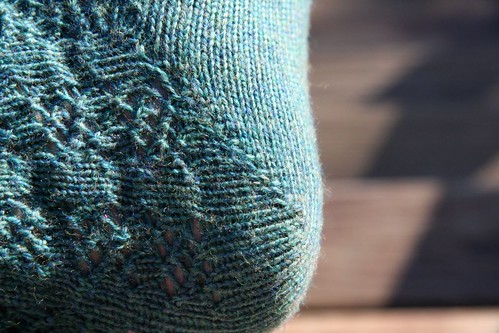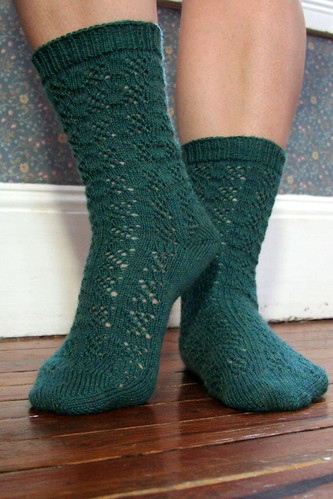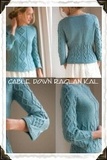That Nancy Bush, man. She can really design a pair of socks.

Nancy Bush is one of the only designers for whom I will happily knit socks from the top-down, and I'm really happy when I do.
 Pattern:
Pattern: Fancy Silk Sock for a Child of 5 or 6 Years by Nancy Bush, from the book
Knitting Vintage Socks; my project is
here on RavelrySize: US women's 9
Yarn: Knit Picks Stroll 4-ply fingering weight, in Glacial, 75% Merino wool / 25% nylon; I used 71.9 grams, which was approximately 332.6 yards/ 304.2 meters
Needles: Knit Picks size 1.5 (2.5 mm) nickel-plated DPNs, set of 5
Modifications: added one lace repeat to lengthen the leg, otherwise knit as written
Started: January 2, 2010
Finished: February 17, 2010
I've wanted to knit these socks for a while, and the January Sock Knitters Anonymous challenge featuring Nancy Bush as a designer provided the perfect opportunity. While knitting, I wondered why I enjoy Nancy Bush patterns so very much, and I think it's the utter clarity of design, which is carried through in the directions. Every stitch is accounted for, with patterns that are logical and intuitive, with clever transitions and connections among motifs, as well as ways for keeping track of progress that aren't tedious, such as counting the selvedge chains on the heel flap.

A lot of the sock patterns I've seen are essentially some stitch pattern plugged into a basic sock formula, which is what makes them so easy to convert to toe-up. I like that Nancy (yeah, we're going to be on a first-name basis now) really thought through ways to incorporate the vintage shapes into an overall harmonious flow of stitchery that results in not just a sock, but really a bit of artistry.

And yet, these delicate little tulip shapes blooming up the leg, as well as the dancing lace between them, are incredibly easy and fast to work, which of course I have to love. This portion of the design could have been worked upside-down, but I don't think it would have the same dimensionality and rhythm.

I'm completely in love with the yarn. It is creamy and squishy and soft, yet strong and durable, making for a lovely sock that feels great on the feet, but holds up to wearing with shoes. I have great love for Knit Picks, and this yarn is one of the ones I'd most highly recommend.
Oh, and the color. It's this agonizingly beautiful minty bluish greenish color, very accurately named for its similarity to glacial ice (which I will be seeing a lot of on my upcoming trip to Iceland). It also conjures a particularly delightful chapter in the D.H. Lawrence book
Women in Love called "Crème de Menthe," along with general mint green frostings and creamy, decadent things. It may be weird to associate this color with romance and indulgence, but I picture it somehow with cushy white spa robes and crisp white sheets, gentleness and tenderness and all kinds of mushy things.

My only misgiving of sorts, with these socks, is that the lace cuff at the top is a little tight, which prevented me from lengthening the leg as much as I wanted to. I'd read recommendations to work it with a larger needle, and I meant to, then forgot at the last minute and went at it with the 1.5 size. I figured I should be alright since I'd already gone up a half size from the recommended size 1's, but this is a common issue for me with top-down socks. I can probably fix the cuff with some aggressive blocking (though weirdly, I can't
find my sock blockers anywhere!). Still, these are long enough that they don't bother me, and their loveliness makes up for anything else for me.
Previous Entries on this Project:-
For the Love of Nancy Bush
